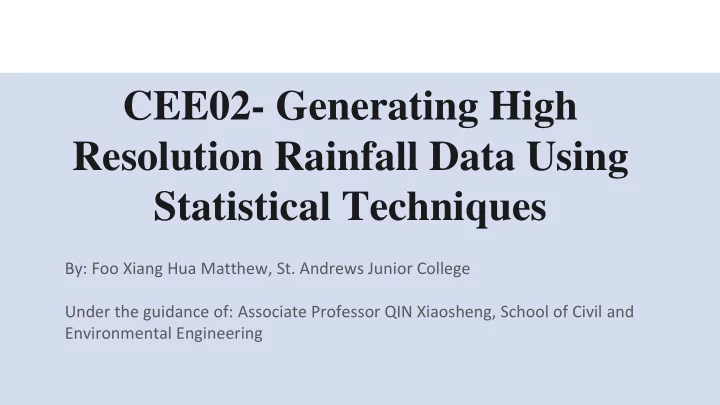

CEE02- Generating High Resolution Rainfall Data Using Statistical Techniques By: Foo Xiang Hua Matthew, St. Andrews Junior College Under the guidance of: Associate Professor QIN Xiaosheng, School of Civil and Environmental Engineering
General Circulation Models (GCMs) ● General Circulation Models (GCMs) ○ Surface pressure ○ Temperature ○ Relative humidity ○ Geopotential height (gravity- adjusted height) ○ Calculated airflow variables https://drtimball.ca/2012/static-climate-models-in-a-virtually-unknown-dynamic-atmosphere/
General Circulation Models (GCMs) Approximately 300*300 KM at Equator
General Circulation Models (GCMs) Approximately 300*300 KM at Equator
Downscaling Downscaling: Improve resolution/ reduce coarseness Statistical Dynamical Embed a Regional Downscale the GCM Climate Model data (RCM) Identifes correlations Accounts for site- between GCM data specific physical and observed data conditions https://www.climateprediction.net/climate-science/climate-modelling/regional-models/
Downscaling ● ● Advantages Advantages Downscaling: Improve resolution/ ○ ○ Higher resolution of Computationally reduce coarseness small scale inexpensive atmospheric features ○ Multiple scenarios, Statistical useful for Dynamical uncertainty ● Disadvantages analysis ● Disadvantages ○ Computationally Embed a Regional ○ expensive Assumes a Mathematical model Climate Model significant and (RCM) stationary ○ Dependent on relationship quality of GCM Identify correlations Account for site- ○ Dependent on ○ Sensitive to choice between GCM data specific physical quality of GCM of boundary and observed data conditions conditions ○ Depends on selection of predictor variables
Downscaling Mathematical relationship https://www.climateprediction.net/climate-science/climate-modelling/regional-models/
Statistical DownScaling Model (SDSM) ● Aim: Downscale precipitation over Singapore ● Study area: Singapore ● GCMs used (predictors): ○ Hadley Centre Coupled Model (HadCM3) ○ Canadian Earth System Model (CanESM2) ○ NCEP/NCAR Reanalysis data ● Rainfall records (predictand): Changi Climate Station daily precipitation ● Time period: 1967-2005 (hindcast) ● Software used: Statistical Downscaling Model (SDSM)
Statistical DownScaling Model (SDSM)-- Methodology ● Step 1- Data transformation ● Four experiments were conducted ● Two experiments involved predictand transformation to 0.25 power Experiments HadCM3 CIMP5 Predictand Non Predictand Non transformed to transformed transformed to transformed power 0.25 predictand power 0.25 predictand
Statistical DownScaling Model (SDSM)-- Methodology ● Step 2- Screen Variables ● Conditional process for precipitation, unconditional for rainfall ● Test predictors in correlation matrix ● Select predictors with highest correlations
Statistical DownScaling Model (SDSM)-- Methodology ● Step 3- Calibrate Model ● Predictors with highest correlation used to calibrate model ● .PAR file created
Statistical DownScaling Model (SDSM)-- Methodology ● Step 4- Weather Generator ● .PAR file used as input ● .SIM and .OUT file created ● Number of ensembles = Number of generated scenarios
Results ● ● Analysed in Analysed features ○ Monthly series ○ Mean ○ Monsoon seasons ○ Variance 90 th percentile ○ ○ Weekly analysis ○ Maximum ○ Minimum ○ Percentage of wet days ○ Percentage of dry days
Results-- Monthly analysis 12.000 ● July 10.000 Each July from 1967 rainfall Rainfall in mm to 2005 was analysed 8.000 mean for mean values 6.000 CanESM2 4.000 July mean ● Downscaled scenario 2.000 was unable to 0.000 replicate variability CanESM2 1967 1969 1971 1973 1975 1977 1979 1981 1983 1985 1987 1989 1991 1993 1995 1997 1999 2001 transforme d mean ● Year HadCM3 was able to CanESM2 HadCM3 Changi July reflect rate of rainfall 12.000 rainfall Transformed -0.009 0.018 0.041 increase (mm/ year) 10.000 mean Rainfall in mm more accurately 8.000 HadCM3 Non- -0.017 0.022 6.000 rainfall transformed mean 4.000 2.000 HadCM3 transform 0.000 ed rainfall 1967 1969 1971 1973 1975 1977 1979 1981 1983 1985 1987 1989 1991 1993 1995 1997 1999 2001 mean Year
Results-- Monthly analysis ● Data transformation 30 25 appears to cause Rainfall in mm 20 HadCM3 uncertainty to be 15 mean 10 more varied (height of 5 July error bars) 0 rainfall 1967 1969 1971 1973 1975 1977 1979 1981 1983 1985 1987 1989 1991 1993 1995 1997 1999 2001 mean Year 35 30 HadCM3 25 Rainfall in mm transforme 20 d mean 15 10 5 July 0 rainfall mean Year
Results-- Monsoon analysis ● Each North East Monsoon dry season (January to early March) from 1967 to 2005 was analysed for maximums 300.000 NEM dry max rainfall 250.000 200.000 Rainfall in mm CanESM2 transformed max 150.000 100.000 HadCM3 transformed max 50.000 0.000 CanESM2 max HadCM3 max Year
Results-- Weekly analysis 120.000% Changi 100.000% ● Analysed for percentage Percentage of wet days climate station of wet days in a week 80.000% week 1-72 60.000% HadCM3 ● Five day week week 1-72 40.000% 20.000% ● Year 1967 HadCM3 0.000% transformed 1 4 7 10 13 16 19 22 25 28 31 34 37 40 43 46 49 52 55 58 61 64 67 70 week 1-72 ● Range was Week number 120.000% underestimated Changi Percentage of wet days 100.000% climate station ● Data transformation 80.000% week 1-72 leads to consistently CanESM2 60.000% higher values week1-72 40.000% ● No distinct wet or dry 20.000% CanESM2 transforme downscaled periods 0.000% d 1-72 1 4 7 10 13 16 19 22 25 28 31 34 37 40 43 46 49 52 55 58 61 64 67 70 Week number
Conclusion ● Poorly generated scenarios due to ○ Missing December 1969 and October and November in 1971 in Changi Climate records ○ Large number of HadCM3 predictors registered missing values ○ Poor correlations between predictors and predictand ● Possible improvements ○ Use of bias correction ○ Alternative predictor selection methods – consider partial correlations
Conclusion Thank you for your kind attention
Recommend
More recommend